What is customer intelligence & how to gather all that data

Senior Product Marketing Manager - Dialpad Support
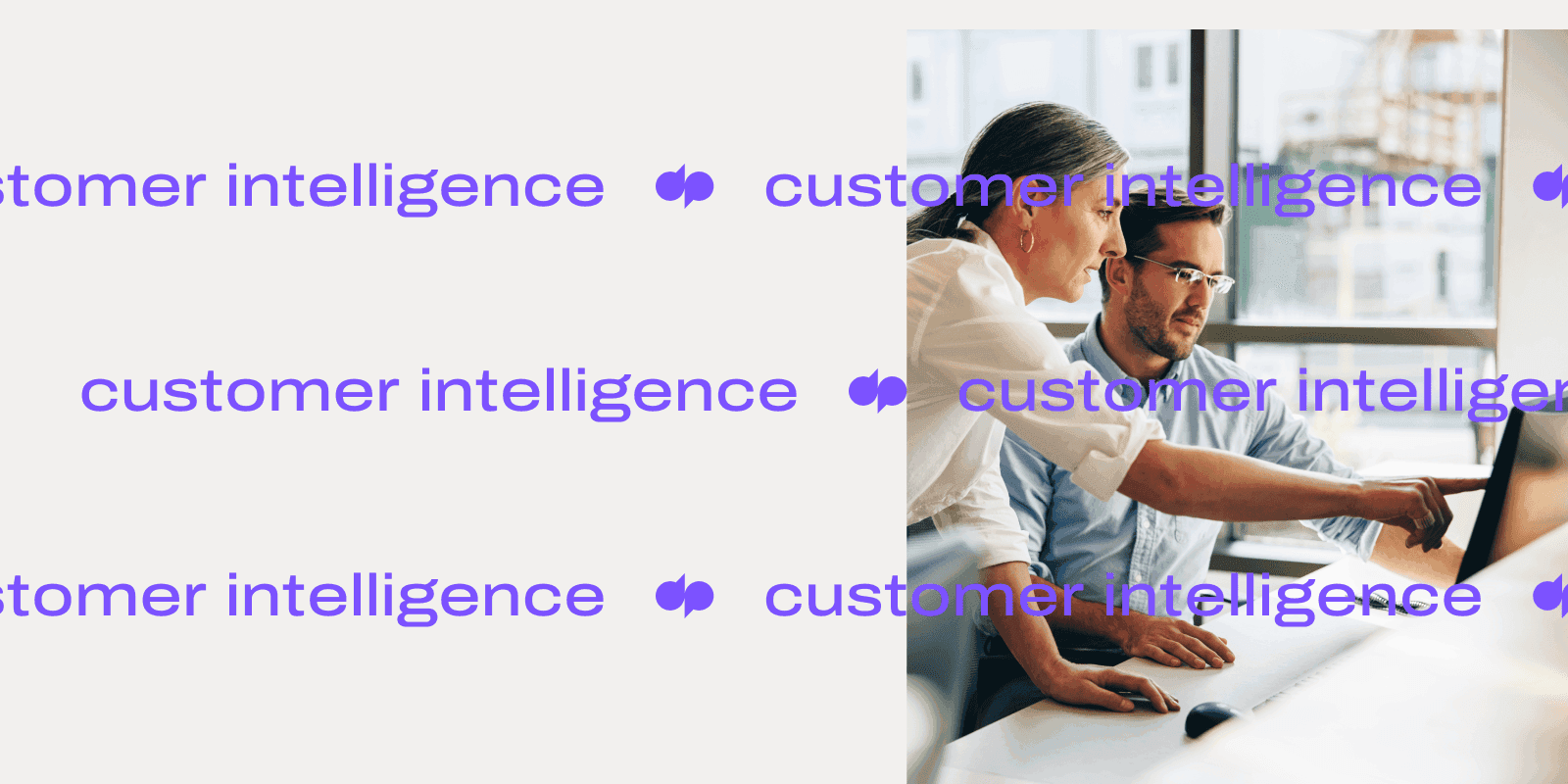
Tags
Share
Customer intelligence is one of the most underused—and most powerful—sources of insight you have as a company.
Not only can customer intelligence data help you improve your customer engagement and optimize customer retention, but it’s also surprisingly inexpensive—and easy—to collect. So, why do so many businesses still not have a strategy in place to use or even just collect data?
In this guide, I’ll show you how both large and small businesses, whether they‘re in financial services or retail, can use customer intelligence to win more customers and improve their bottom line.
But first...
What is customer intelligence?
Customer intelligence is essentially any data about your potential, current, and past customers that tells you more about what they want from you as a company. What’s important to keep in mind is that this is an incredibly broad category. Yes, you could do market research surveys and even transaction data to gather customer intelligence about what your customers like or dislike, and what kinds of products or services you should offer... But there’s a lot more you could do.
For example, you could look at behavioral data and your customer interactions to get a better sense of which communication channels or touchpoints they prefer.
And in fact, your customer communications—the conversations you‘re having every day on the phone, through live chat, and so on—are the cheapest sources of customer insights you have. I’ll talk more about this in just a bit.
Types of customer intelligence
Transactional data
Transactional data is information about customer transactions, like what products they’ve purchased, when they made the purchase, and how much they paid. This type of data can be used to track purchasing behavior over time and identify preferences and trends.
Behavioral data
Behavioral data is typically information about how customers interact with a company, from marketing to customer support activities. This can include things like website clicks, call center interactions, and social media engagement. This type of data can be used to understand how customers use a product or service and identify areas for improvement. This type of data is particularly useful for customer support, customer success, and sales teams.
Psychographic data
Psychographic data is information about customers’ psychological profiles, such as their personality type, values, and attitudes. Marketers are usually the team that’s most interested in this type of data, since they can use it to segment customers into groups for different campaigns and tailor product offerings to specific groups of customers.
Demographic data
Demographic data is information about customer demographics, such as age, gender, income level, education level, and location. This type of data can be used to understand the makeup of a customer base and target marketing efforts at specific groups of people.
A few other examples of customer intelligence data
I mentioned a few use cases for customer data earlier, but there‘s a wide, wide range of possible types of customer information that you could be collecting:
Recordings or transcripts of your phone calls with customers and prospects (collected with their consent, of course)
Customer behavior like purchase history (which should be logged in your CRM or customer relationship management platform)
Responses to marketing campaigns (did they click on your email newsletter, and then buy something on your website?)
Demographic information
Social media trends
Customer lifecycle information (are they a new prospect, or are they a repeat customer who loves cross-sell and upsell offers?)
And a lot more...
As you can see, there are many different types of customer intelligence you can collect. But if you can do this well, you‘ll have a goldmine of actionable insights that‘ll help you increase customer loyalty, customer lifetime value, profitability—and many other important metrics.
The benefits of having good customer intelligence
Personalized customer experiences
Personalized customer experiences are becoming increasingly important as customers expect companies to know them and their preferences. If you have customer intelligence—say, if you know what types of products your customers have purchased in the past—it makes it possible to understand how you can create tailored experiences that meet their needs, which can lead to increased satisfaction and loyalty.
Lower customer churn rates
On a related note, lowering customer churn rates is another benefit. By understanding what causes customers to leave (and what makes them stick around), companies can take steps to reduce customer churn. Often, small changes can make a big difference in retention rates. For example, if a company knows that a customer is at risk of churning, they can offer them a discount or other incentive to stay.
Increased customer loyalty
Closely tied to churn is increasing customer loyalty. When customers feel valued and have smooth support experiences, they are more likely to be loyal and stay with a business for a longer time—which ultimately leads to higher customer lifetime values.
More data-driven decision making
Finally, having customer intelligence empowers you to make more data-driven decisions. For example, instead of guessing whether your customers are satisfied with your customer support experience, or going by anecdotes alone, you could collect actual data (like CSAT scores) that supports your decisions.
How to gather customer intelligence: Know where to look
With so many different types of customer intelligence data, where should you start looking? What types of information should you collect? Here are some of the most important ones to consider.
1. Customer satisfaction surveys
Even though CSAT surveys sound pretty great, there’s one big challenge with them: they tend to get low customer engagement. In other words, not a lot of customers actually fill them out.
In fact (depending on the industry and specific business of course), we've found that on average only about 5% of customers actually fill out CSAT surveys. On a related note, usually only the angriest—and happiest—customers actually bother to respond to these surveys, which means your CSAT answers are likely to be very skewed and not representative of how your customers feel overall.
CSAT (customer satisfaction) scores are probably one of the most popular metrics out there, across different industries and company sizes. And for good reason. CSAT surveys are relatively easy to set up and send out, and they tell you directly what your customers are thinking.
If you’ve ever called a company or had a live chat conversation on their website, you’ve probably come across a simple one- or two-question survey asking you to rate your customer satisfaction on a scale from one to five (or from “very sad face” to “very happy face”).
Our own support team, for example, uses Dialpad Support as our contact center platform—and we can set up a CSAT survey to automatically play after a customer call. It’s really easy and takes just a few clicks:
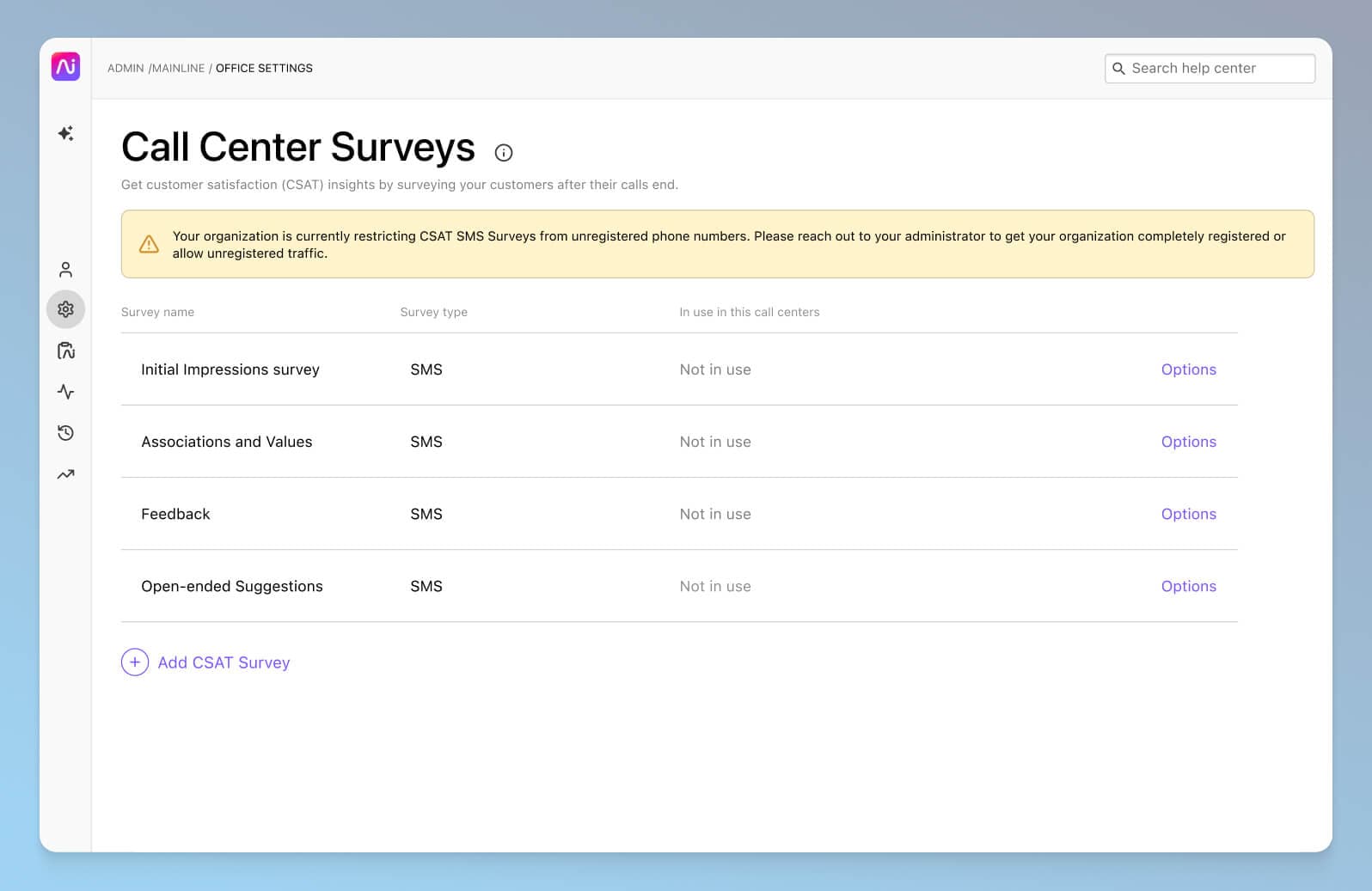
Dialpad's industry-first predictive Ai CSAT feature does another important—and unique—thing. Not only can our artificial intelligence feature transcribe calls and analyze sentiment in real time, it can also infer CSAT scores for 100% of your customer calls thanks to its hyper-accurate transcription feature. The result? A much more representative sample size that takes more individual customers’ feedback into consideration, and a more accurate understanding of how satisfied your customers really are:
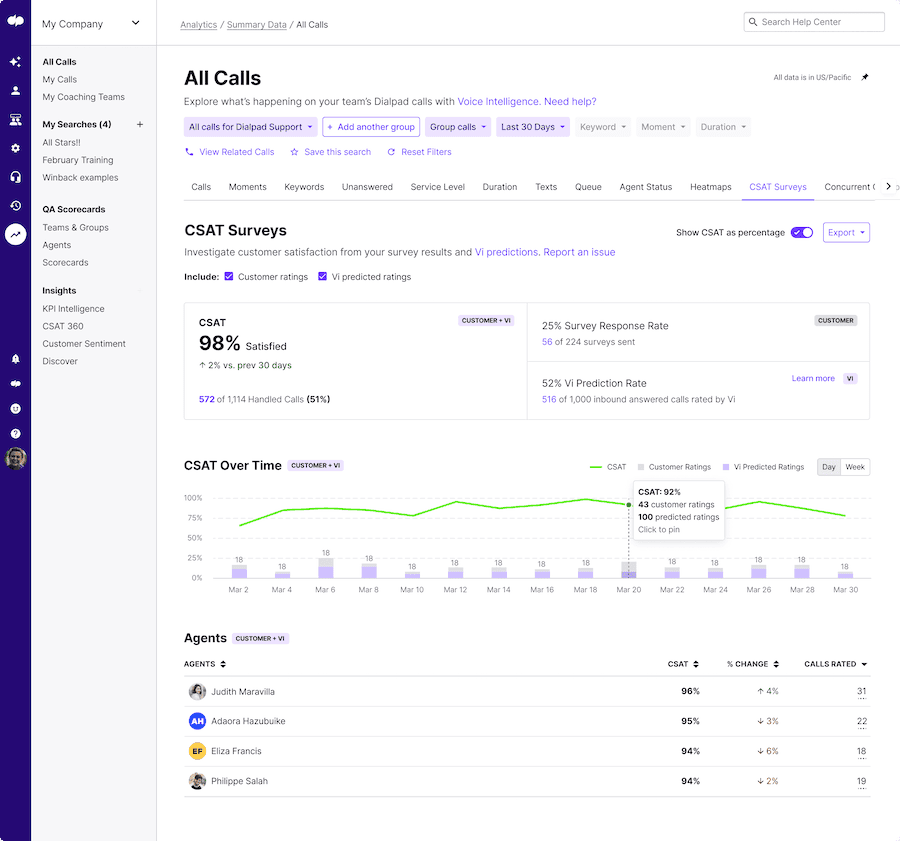
(And thanks to machine learning, it gets more and more accurate as it learns from a larger data set!)
2. Call recordings and transcripts
In contrast to CSAT surveys, which are pretty well-known, there are surprisingly few businesses using their customer communications as a source of insights.
It may seem like a difficult thing to do, especially if you have a small team, but if you have a good contact center platform, this will take care of the heavy lifting for you.
For example, Dialpad Support comes with a call recording feature (that automatically turns off when sensitive information is being discussed, for compliance), and not only that, it also transcribes calls—in real time:
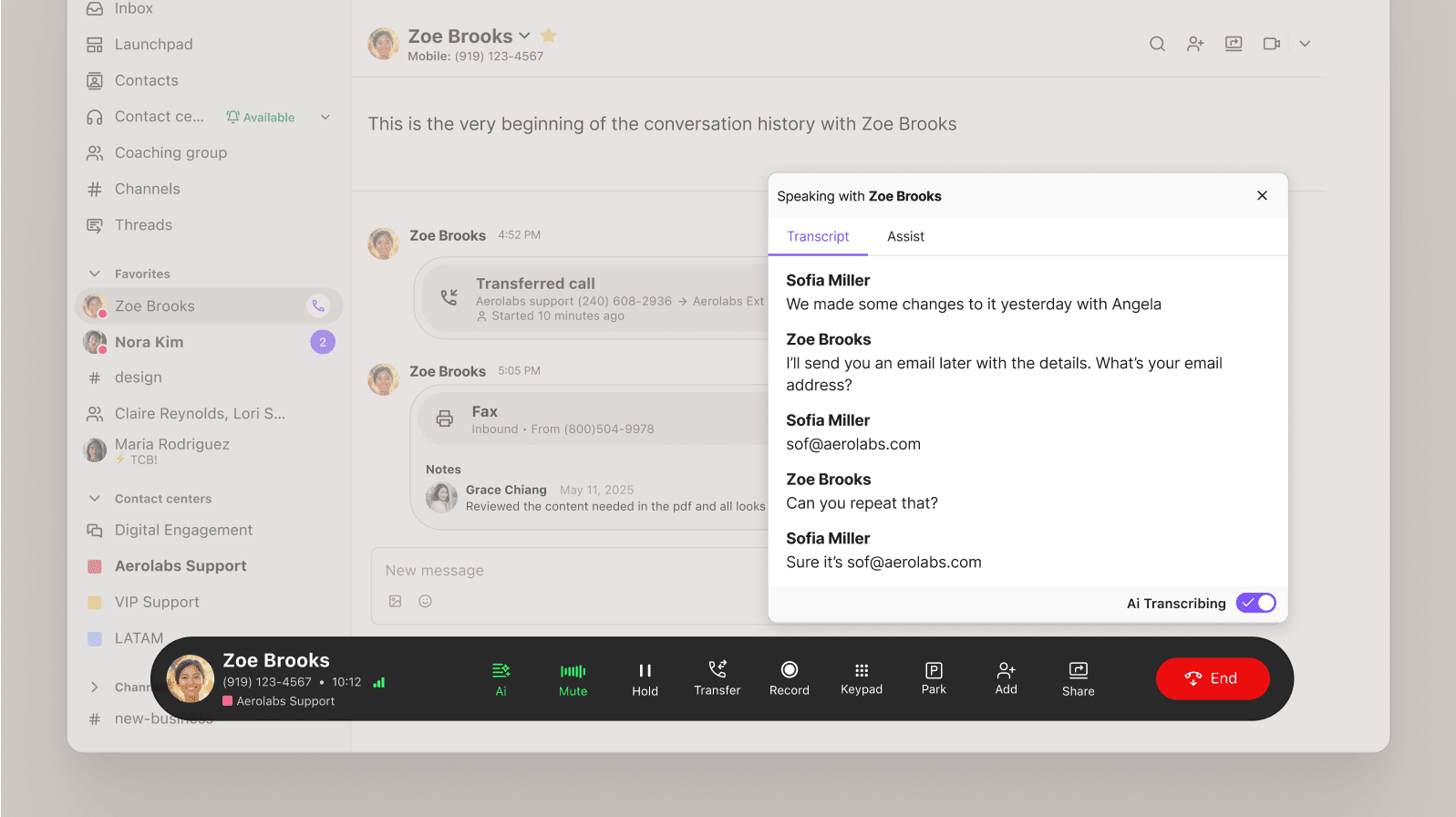
We can search the transcripts and skip to specific parts of the conversation when reviewing these calls after, which is very helpful for agent training and development.
Another creative way to use call recordings as customer intelligence: We can create “playlists” with recordings. Say we have some great examples of how agents handled a difficult customer, or some examples of what not to do. We can share these playlists with the team to help them learn from real examples:
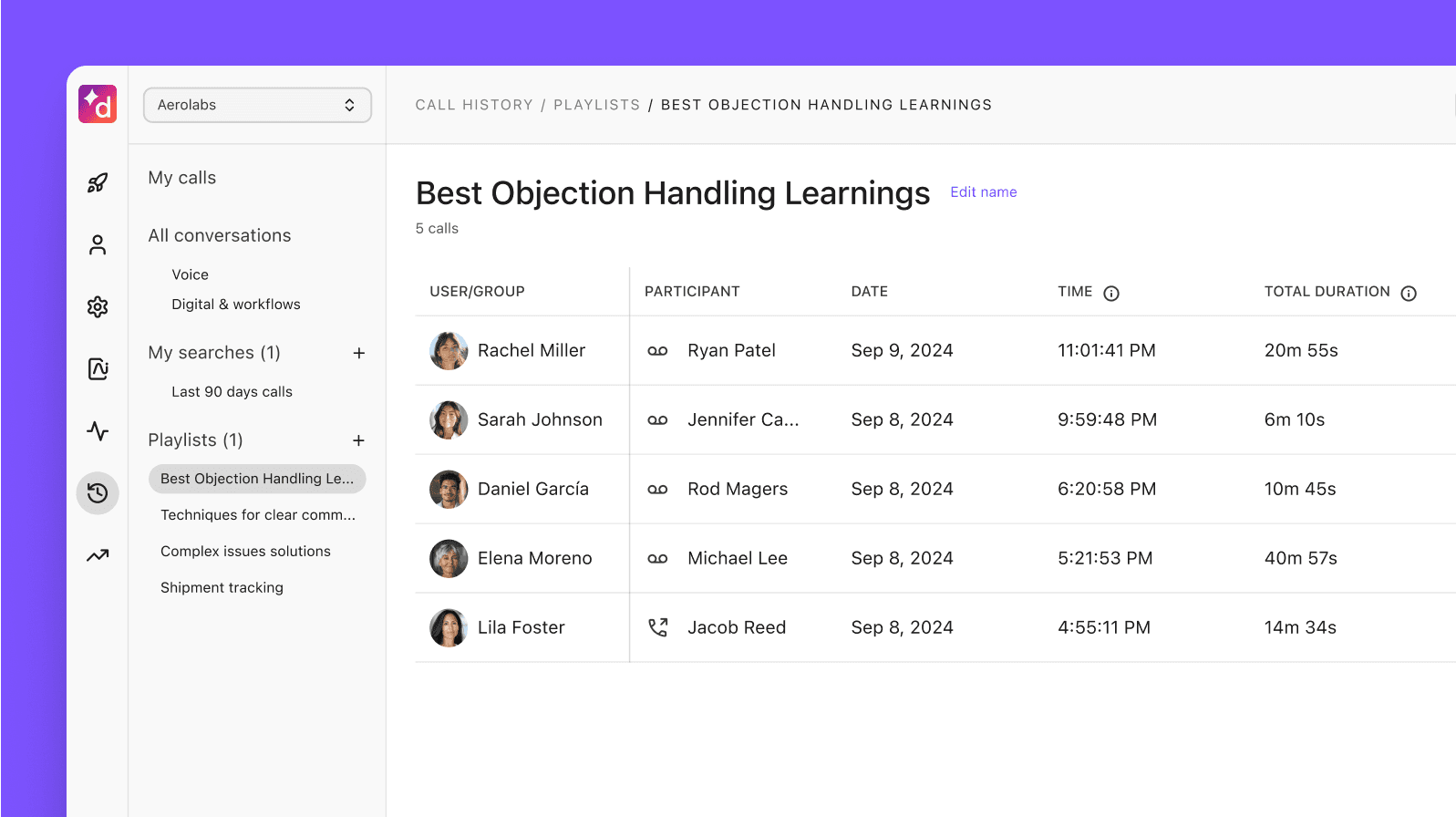
What’s more customer-centric than learning from what your customers are telling you?
3. Customer reviews
Another great source of customer intelligence! What’s great about customer reviews is that this is an easy data source to find. From Google Reviews to third party review sites, these are a great way to learn about what customers like about your products or services—and also where you can improve.
📚 Further reading:
Don‘t have a lot of reviews right now? Learn about how we got more customer reviews (with a small team)!
4. An integrated CRM
One of your most important data sources when it comes to customer intelligence is your CRM, or customer relationship management software. Whether you’re using Salesforce, HubSpot, or your own homegrown CRM, this is where you’d store all your customer information, from where they’re at in their customer journey, to which of your products they’ve shown interest in before, to their customer profile details.
Essentially, it gives you an in-depth single customer view for all your prospects and current customers—and more importantly, lets your supervisors or managers analyze customers’ interactions with your business.
A CRM tip (if you haven’t already done this): Make sure your phone system or contact center software integrates with your CRM. This will streamline your workflows and reduce a lot of your manual data entry tasks. For example, Dialpad’s integration with HubSpot not only embeds the dialer inside HubSpot (so you can make phone calls from there), but also automatically logs customer interactions and dispositions so you can examine them later:
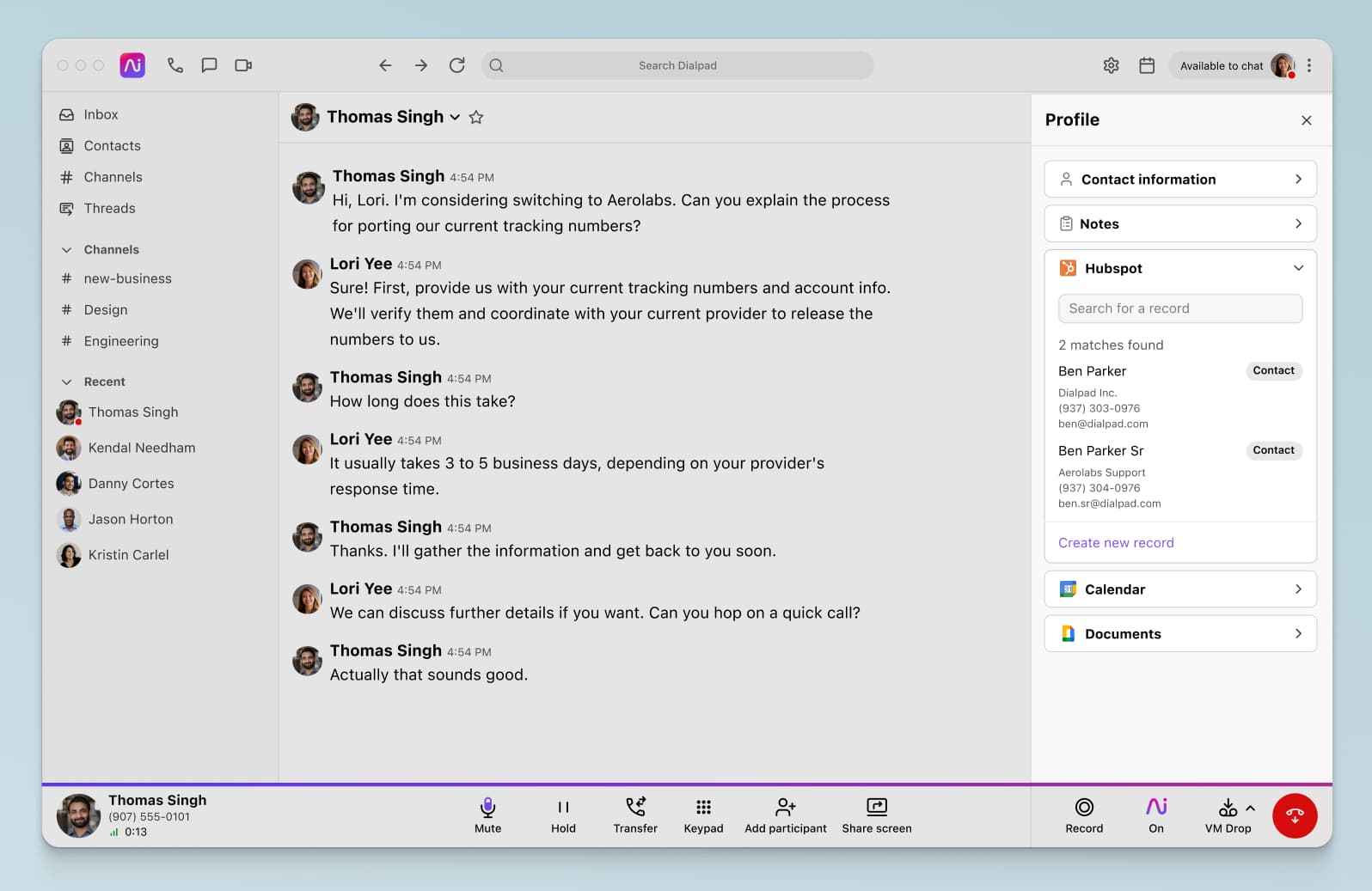
If you’re looking for a ”customer intelligence platform,” having an integrated CRM + contact center software will typically give you what you need. By integrating data extraction software, you can automate the capture and analysis of detailed customer interactions within your CRM, enhancing customer insight with minimal effort.
Key considerations when building a customer intelligence strategy
Now, let’s look at a few things to keep in mind as you build out your overall strategy.
Tools and technology
You can’t just use a spreadsheet or Word document to record customer feedback or information anymore. (Well, you could, but it would be hugely inefficient.)
A good cloud contact center solution, with AI functionality that can help you glean insights from your conversations, is an essential part of your tech stack. For example, can it transcribe customer calls in real time? Can it track common topics or keywords that are brought up?
Compliance and legal issues
In addition, you need to keep compliance and legal issues in mind when collecting and storing data. There are many regulations surrounding data privacy, so it’s important to consult with your legal team if you’re planning to collect any customer data.
Learn more in our AI Compliance Guide.
The types of data needed
If you’re not careful, you might fall into the trap of trying to do too much and collecting too much data. Not only is that difficult to do, it also creates a lot more work and potential confusion later because you’ll still have to sift through and analyze all that data. Migrating your database from SQLite to PostgreSQL can help streamline your data management process.
Try to keep your requirements tight, and if you have to, gradually expand the types of customer intelligence you need instead of trying to collect all the data possible from the onset.
KPIs and metrics
Finally, you need to set KPIs and metrics in order to track your progress and measure success. Some key metrics that customer intelligence can impact include customer lifetime value (CLV), customer satisfaction (CSAT), and Net Promoter Score (NPS).
Common mistakes companies make when gathering customer intelligence
Only looking at quantitative data
When it comes to data management and customer analytics, one of the most common mistakes that companies make is looking exclusively at the numbers.
Fancy algorithms and spreadsheets aside, there’s a lot of qualitative customer intelligence data you could be using too.
Specifically, the things that your customers are saying in their conversations with you. This is very important context that you absolutely need for effective decision-making. For example, if you find that your customers are rating your customer experience a 4 out of 5—great, but why are you missing out on that perfect score?
Numbers alone won’t tell you why. That’s why Dialpad Support and its many automation features are so helpful for our customer support team. Not only does it transcribe calls in real time, it can also track any topics or themes that we’re interested in learning more about.
Say we want to find out how often we get questions about pricing. In Dialpad, we can create a “Custom Moment” to track every time “price” or “pricing” comes up in a customer conversation:
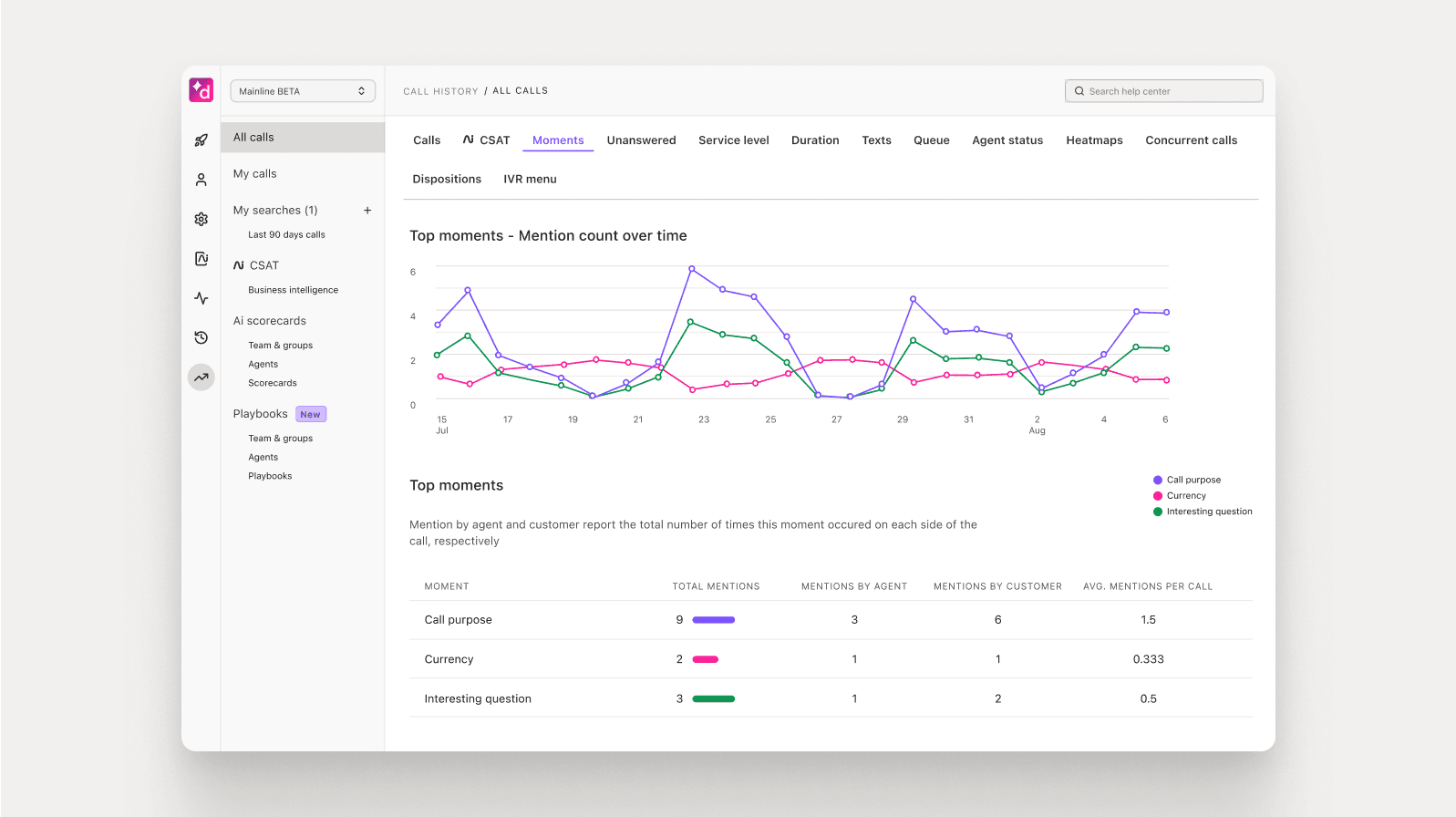
This way, we can segment any topical trends, and if we notice any unusual trends or if people are asking a lot more about pricing for some reason, we can dig into those transcripts to understand why. It’s definitely not your usual business intelligence report, but it’s extremely useful.
Only looking at survey response data
When people talk about ”customer intelligence” data, they’re usually talking about survey or response data. You know, information that customers give you directly in response to you asking them for their opinions or thoughts.
But here’s the thing. This type of data can be expensive and/or hard to collect (many companies will use a third-party survey company), and many companies don’t have the time to run customer surveys.
Again, AI can help. (See examples above with Dialpad’s Ai CSAT feature and transcripts, both of which give you an alternate customer data source beyond just doing market research surveys.)
Not following through on insights
Once you have all this customer data, you have to do something with it! You’d be surprised at how many companies do all the leg-work of collecting survey responses from customers, then let that hard-earned information sit in a folder somewhere.
Not only is this a waste of your team’s own efforts, it also takes away from the customer experience because now, your customers are expecting some kind of follow-up or improvements from you since they took the time to respond to your survey.
How Dialpad acts as our customer intelligence platform
There are many different types of customer intelligence software out there. Some let you record customer conversations, while others help you spot social media trends. As I mentioned earlier though, a good starting point is to have a contact center platform (for collecting customer data) and a CRM (for storing that customer data).
For example, here are a few ways we do this with our own product, Dialpad Support.
Transcribes our calls in real time
One of the most important things Dialpad does for us is transcribing our customer conversations. This is important because it turns these conversations into searchable, usable sources of customer intelligence. (Otherwise, you’d have to listen to each customer recording, one by one, to dig out insights, which takes a lot more time and effort.)
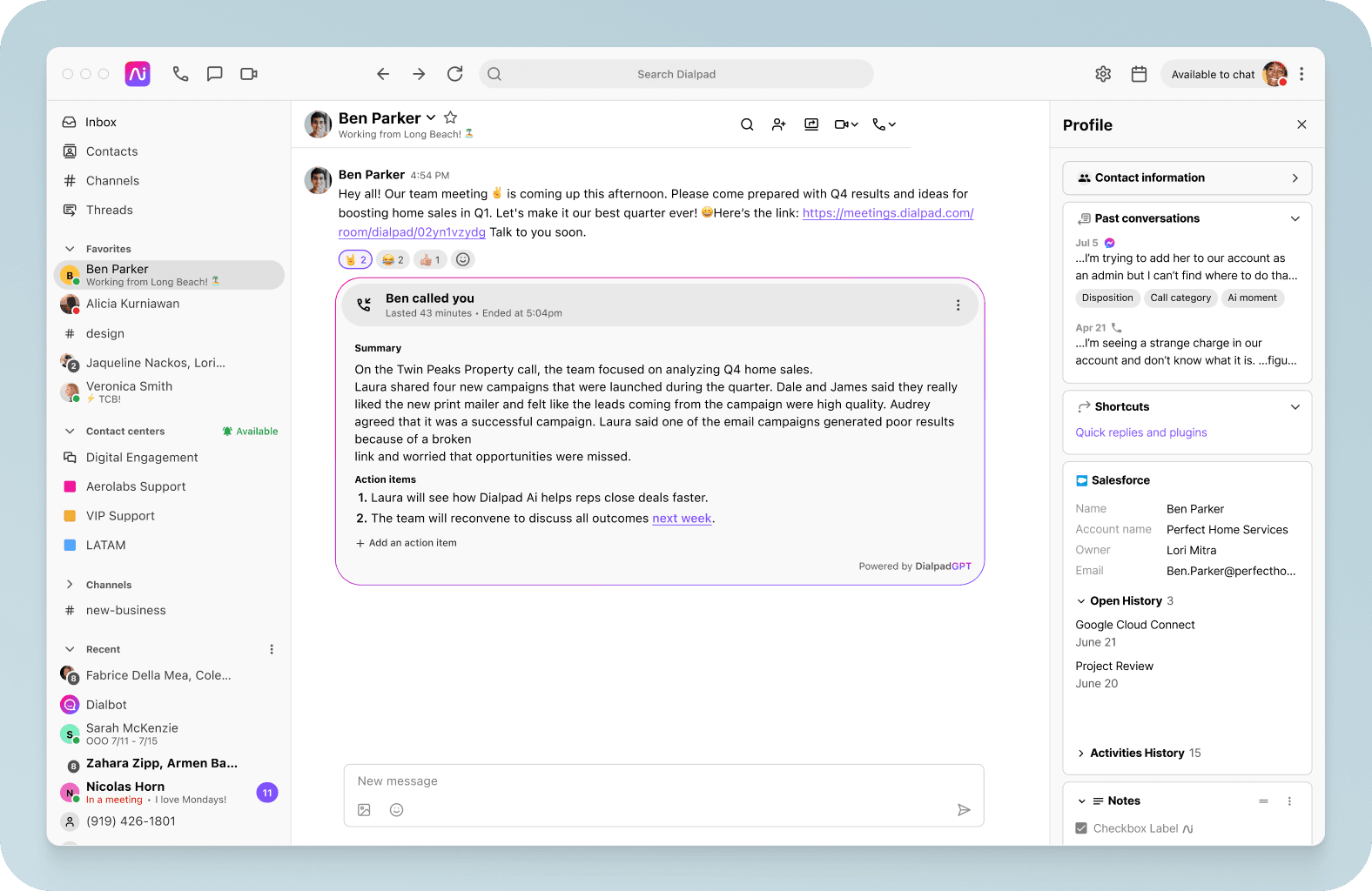
Lets us provide omnichannel service
Like many companies, our customers reach out to us on a variety of different communication channels every day. From chatbot messages to social media conversations, we have to provide a consistent customer experience across all of these channels.
What that also means is that we have more potential sources of customer intelligence. For example, our chatbot functionality is unique in that it doesn’t just provide preset answers to preset questions—it can also search unstructured sources of data, like PDF documents and even past customer conversations, to find answers to tricky questions!
Our agents can also handle all these channels, including chatbot responses and social media messages—from one convenient place in Dialpad:
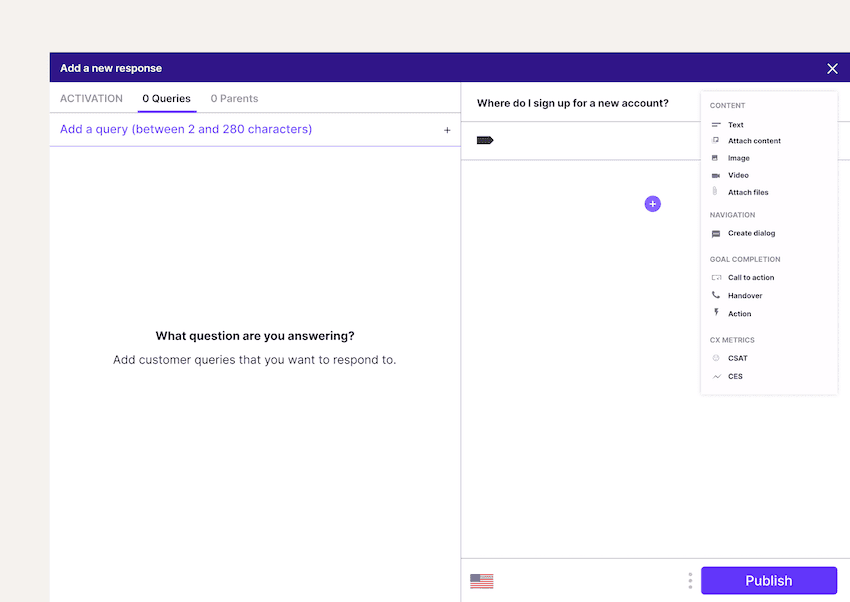
Centralizes customer data in one place
Because Dialpad integrates with our CRM, we can see all our customer profiles, relationship histories, and other useful customer intelligence information, all in one place. When our agents or sales reps are on calls, this pops up automatically for them, which saves them an extra step since they don’t have to manually pull up this information.
Are you getting the most out of your customer intelligence?
Whether you want to better understand your different customer segments, reduce customer churn, or get more actionable insights out of your data platform, these are all related to having a good customer intelligence strategy.
And if you need a good contact center platform that’s designed to help you gather more insights, optimize your touchpoints across different channels, and better understand your customers, why not see how Dialpad Support works?
Need a better way to gather customer intelligence?
Book a demo to see how Dialpad Support can help you gather, sort, and learn from customer conversations across social media messages, live chats, phone calls, and more. Or, take a self-guided interactive tour of the app on your own!
